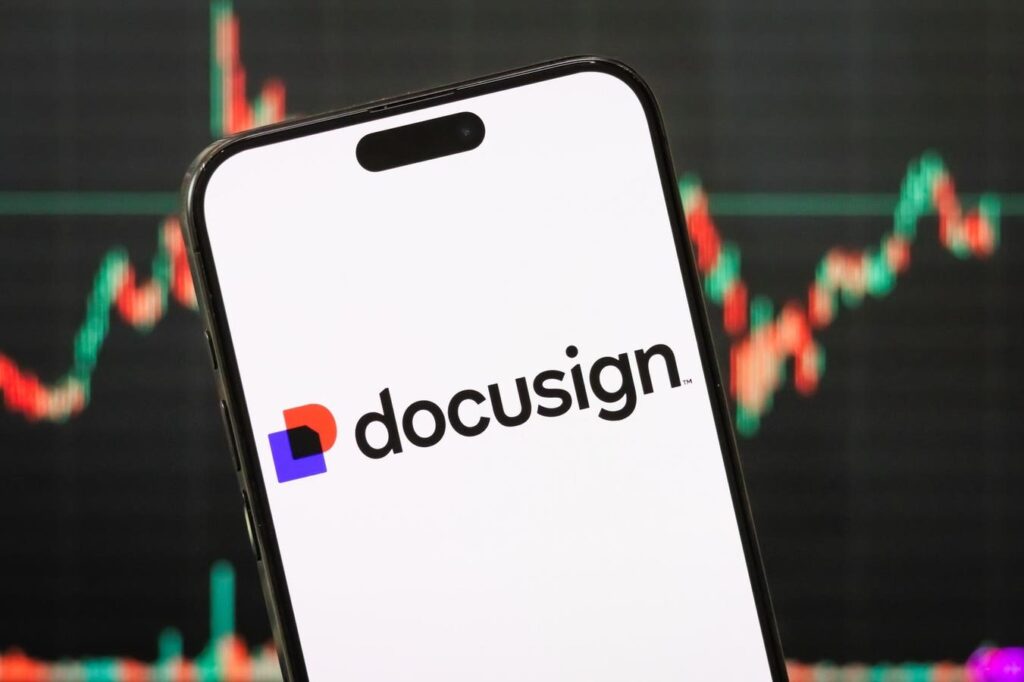DocuSign (NASDAQ: DOCU) recently announced its fiscal first-quarter results for the period ending April 2025, reporting earnings of $0.90 per share on revenues of $763.7 million. These figures represent a 9.8% year-over-year increase in earnings and a 7.6% rise in sales, both exceeding Wall Street’s expectations of $0.81 per share and $748.1 million, respectively. The company’s Q2 sales outlook of $779 million also slightly surpassed street estimates.
Despite this strong performance, DOCU stock experienced a significant 17% plunge in after-hours trading on Thursday, June 5. This decline can be partly attributed to investor concerns over slowing growth. While DocuSign’s revenue grew at an average annual rate of 12.3% over the past three years, current consensus estimates project mid-single-digit sales growth for the next couple of years. Although the company is actively pursuing AI-driven innovation, including the integration of its DocuSign IAM platform into Salesforce deployments, the overall growth trajectory appears less robust than in previous periods. Now, of course, individual stocks are more volatile than a portfolio – and if you seek upside with less volatility than a single stock, consider the High Quality portfolio, which has outperformed the S&P 500 and achieved returns greater than 91% since inception.
As of its close yesterday at $93, DOCU stock was trading at 6.6 times trailing revenues and 26 times trailing adjusted earnings, which suggests it is not cheap. For context, the benchmark S&P 500 index trades at 3 times trailing revenues, with an average revenue growth rate of 5.5% over the last three years. This implies DocuSign is trading at roughly twice the multiple of the benchmark, despite having similar anticipated revenue growth. Look at DocuSign’s Valuation Ratios for more details.
One might wonder if DocuSign’s profitability justifies such a premium valuation. However, DocuSign’s operating margin of 8% is considerably lower than the benchmark index’s 13%. On a positive note, DocuSign’s financial position is strong, with debt at a low 0.7% of equity and cash representing 24% of assets. Nevertheless, this alone does not fully warrant its current premium valuation.
Furthermore, DOCU is not necessarily a safe stock. Historical evidence from the recent economic downturn during the inflation shock in 2022 shows that DOCU stock lost as much as 56% of its value over just a few quarters. See – Buy or Sell DOCU Stock.
DocuSign presents a mixed bag of opportunities and challenges. On the negative side, it faces increased competition, particularly from Adobe, and market maturation after experiencing explosive growth during the pandemic, as businesses rapidly digitized. On the positive side, its expansion into broader agreement management, moving beyond just capturing signatures to managing entire contract workflows, positions it for future growth.
Overall, investors should consider DocuSign as a company with mid to high single-digit sales growth potential. Even at a valuation of 4 times trailing revenues, DOCU would be worth under $60, representing a more than 35% decline from its Thursday’s close.
Of course, this assessment could be wrong. Investors might be willing to pay a premium for DOCU stock, banking on its AI-driven innovations to spur significant future growth. Sometimes, investor enthusiasm for a company’s outlook can lead to valuations that temporarily outweigh fundamental metrics. In fact, taming valuation contextually is just one of the many approaches we take while constructing the 30-stock Trefis High Quality (HQ) Portfolio, which has a track record of comfortably outperforming the S&P 500 over the last 4-year period. Why is that? As a group, HQ Portfolio stocks provided better returns with less risk versus the benchmark index; less of a roller-coaster ride, as evident in HQ Portfolio performance metrics.
Read the full article here


